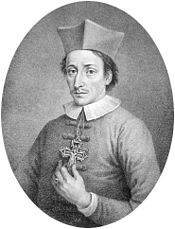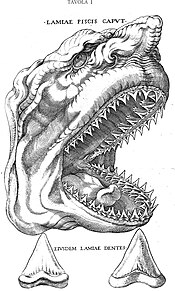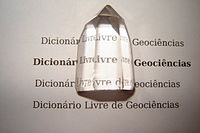| No Title | |
|---|---|
[[ |250px]] |250px]]Nicolas Steno
| |
|
No Title |
No information |
Nicolas Steno (Danish: Niels Stensen; Latinized to Nicolaus Stenonis, Italian Niccolo' Stenone) (11 January 1638 - 25 November 1686) was a Danish pioneer in both anatomy and geology. Already in 1659 he decided not to accept anything simply written in a book, instead resolving to do research himself.[1] He is considered the father of geology and stratigraphy.[2]
Early career[]
Nicolas Steno was born in Copenhagen on New Year's Day (Julian calendar), the son of a Lutheran goldsmith who worked regularly for King Christian IV of Denmark. Stensen grew up in isolation in his childhood, because of an unknown disease. In 1644 his father died, after which his mother remarried another goldsmith. In 1654-1655, 240 pupils of his school died because of the plague. Across the street lived Peder Schumacher, (who would offer Steno a post as professor in Copenhagen in 1671). After completing his university education, Steno set out to travel through Europe; in fact, he would be on the move for the rest of his life. In the Netherlands, France, Italy and Germany he came into contact with prominent physicians and scientists. These influences led him to use his own powers of observation to make important scientific discoveries. At a time when scientific questions were mostly answered by appeal to ancient authorities, Steno was bold enough to trust his own eyes, even when his observations differed from traditional doctrines.
At the urging of Thomas Bartholin, Steno first travelled to Rostock, then to Amsterdam, where he studied anatomy under Gerard Blasius, focusing again on the Lymphatic system. Steno discovered a previously undescribed structure, the "ductus stenonianus" (the duct of the parotid salivary gland) in sheep, dog and rabbit heads. A dispute with Blasius over credit for the discovery arose, but Steno's name is associated with this structure.[3] Within a few months Steno moved to Leiden, where he met the students Jan Swammerdam, Frederik Ruysch, Reinier de Graaf, Franciscus de le Boe Sylvius, a famous professor, and Baruch Spinoza.[4] Also Descartes was publishing on the working of the brain, and Steno did not think his explanation of the origin of tears was correct. Steno studied the heart, and determined that it was an ordinary muscle.
He travelled to Saumur where he met Melchisédech Thévenot and Ole Borch. Steno travelled to Montpellier, where he met Martin Lister and William Croone, who introduced Steno's work to the Royal Society. In Pisa Steno met the Grand Duke of Tuscany, who supported arts and science. Steno was invited to live in the Palazzo Vecchio, in return he had to gather a Cabinet of curiosities. Steno first went to Rome and met Alexander VII and Marcello Malpighi. As an anatomist in the hospital Steno focused on the muscular system and the nature of muscle contraction. He also became a member of Accademia del Cimento in Florence. Like Vincenzio Viviani Steno used geometry to show that a contracting muscle changes its shape but not its volume.
Contributions to paleontology and geology[]

Illustration from Steno's 1667 paper comparing the teeth of a shark head with a fossil tooth
In October 1666 two fishermen caught a huge female shark near the town of Livorno, and Ferdinando II de' Medici, Grand Duke of Tuscany, ordered its head to be sent to Steno. Steno dissected the head and published his findings in 1667. He noted that the shark's teeth bore a striking resemblance to certain stony objects, found embedded within rock formations, that his learned contemporaries were calling glossopetrae or "tongue stones". Ancient authorities, such as the Roman author Pliny the Elder, in his Naturalis Historiae, had suggested that these stones fell from the sky or from the Moon. Others were of the opinion, also following ancient authors, that fossils naturally grew in the rocks. Steno's contemporary Athanasius Kircher, for example, attributed fossils to a "lapidifying virtue diffused through the whole body of the geocosm", consided an inherent characteristic of the earth — an Aristotelian approach. Fabio Colonna, however, had already shown in a convincing way that glossopetrae are shark teeth,[5] in his treaty De glossopetris dissertatio published in 1616.[6] Steno added to Colonna's theory a discussion on the differences in composition between glossopetrae and living sharks' teeth, arguing that the chemical composition of fossils could be altered without changing their form, using the contemporary corpuscular theory of matter.
Steno's work on shark teeth led him to the question of how any solid object could come to be found inside another solid object, such as a rock or a layer of rock. The "solid bodies within solids" that attracted Steno's interest included not only fossils, as we would define them today, but minerals, crystals, encrustations, veins, and even entire rock layers or strata. He published his geologic studies in De solido intra solidum naturaliter contento dissertationis prodromus, or Preliminary discourse to a dissertation on a solid body naturally contained within a solid in 1669. Steno was not the first to identify fossils as being from living organisms; his contemporaries Robert Hooke and John Ray also argued that fossils were the remains of once-living organisms.

Quartz crystal showing transparency.
Steno, in his Dissertationis prodromus of 1669 is credited with three of the defining principles of the science of stratigraphy: the law of superposition: "...at the time when any given stratum was being formed, all the matter resting upon it was fluid, and, therefore, at the time when the lower stratum was being formed, none of the upper strata existed"; the principle of original horizontality: "Strata either perpendicular to the horizon or inclined to the horizon were at one time parallel to the horizon"; the principle of lateral continuity: "Material forming any stratum were continuous over the surface of the Earth unless some other solid bodies stood in the way"; and the principle of cross-cutting discontinuities: "If a body or discontinuity cuts across a stratum, it must have formed after that stratum."[7] These principles were applied and extended in 1772 by Jean-Baptiste L. Romé de l'Isle. Steno's landmark theory that the fossil record was a chronology of different living creatures in different eras was a sine qua non for Darwin's theory of natural selection.
Another principle, known simply as Steno's law, or Steno's law of constant angles, states that the angles between corresponding faces on crystals are the same for all specimens of the same mineral, a fundamental breakthrough that formed the basis of all subsequent inquiries into crystal structure.[8]
Religious studies[]
Steno's questioning mind also influenced his religious views. Having been brought up in the Lutheran faith, he nevertheless questioned its teachings, something which became a burning issue when confronted with Roman Catholicism while studying in Florence. After making comparative theological studies, including reading the Church Fathers and by using his natural observational skills, he decided that Catholicism, rather than Lutheranism, provided more sustenance for his constant inquisitiveness. Steno converted to Catholicism on All Souls' Day when Lavinia Cenami Arnolfini insisted.
Steno travelled to Hungary, Austria and in Spring 1670 he arrived in Amsterdam. There he met with old friends Jan Swammerdam and Reinier de Graaf. With Anna Maria van Schurman and Antoinette Bourignon he discussed scientific and religious topics. The following quote is from a 1673 speech:
- Fair is what we see, Fairer what we have perceived, Fairest what is still in veil.[9]
It is not sure if he met Nicolaes Witsen, but he did read Witsen's book on shipbuilding. In 1671 he accepted a post in Copenhagen, but promised Cosimo III de' Medici he would return when he was appointed tutor to Ferdinando III de' Medici. In 1675 Steno was back in Florence and ordained a priest. Athanasius Kircher expressly asked what the reason was. Steno had left science and became one of the leading figures in the Counter-Reformation.
In the year after he was made bishop, and probably involved in the banning of publications by Spinoza,[10] he came to a mission in Lutheran North by invitation of John Frederick, Duke of Brunswick-Lüneburg. There he had talks with Gottfried Leibniz, the librarian; the two argued about Spinoza and his letter to Albert Burgh, then Steno's pupil.[11] Leibniz recommended a reunification of the churches. Steno worked at the city of Hannover until 1680. He then accepted a position in Münster (Church Saint Liudger) as the new prince-elector Ernest Augustus, Elector of Hanover was a Protestant. Earlier, Augustus' wife, Sophia of Hanover, had made fun of Steno's piousness; he had sold his bishop's ring and cross to help the needy.
In 1684 Steno moved to Hamburg, after an argument about the election of the new bishop, Maximilian Henry of Bavaria. There Steno became involved again in the study of the brain and the nerve system with an old friend Dirck Kerckring. Steno was invited to Schwerin, when it became clear he was not accepted in Hamburg. Steno dressed like a poor man in an old cloak. He drove in an open carriage in snow and rain. Living four days a week on bread on beer he became emaciated.[12] When Steno had fulfilled his mission, some years of difficult tasks, he wanted to go back to Italy. Before he could return, Steno became severely ill, his belly swelling day by day. Steno died in Germany, after much suffering. His corpse was shipped by Kerckring to Florence and buried in the Basilica of San Lorenzo close to his protectors, the De' Medici family. In 1953 his grave was discovered, and the corpse (without the missing skull) was reburied after a procession through the streets of the city.[13]
Legacy[]
Steno's life and work has been studied, in particular in relation to the developments in geology in the late nineteenth century. His piety and virtue have been especially evaluated with a view to an eventual canonization. In 1953 his corpse was exhumed, and reburied in the Capella Stenoniana, but without the missing skull. The Italian state donated a fourth-century Christian sarcophagus that had been found in the river Arno. In 1987 he was declared "beatus" - the first step to being declared a saint - by Pope John Paul II. He is thus now called by Catholics Blessed Nicolas Steno.
- The Steno Museum in Århus, Denmark, named after Nicolas Steno, holds exhibitions on the history of science and medicine.[14] It also operates a planetarium and a medicinal herb garden.
- Impact craters on Mars and the Moon are named in his honor.
- In 1950 the "Niels Steensens Gymnasium", the only Catholic preparatory school in Scandinavia, was founded on a Jesuit monastery in Copenhagen.
- Steno Diabetes Center, a research and teaching hospital dedicated to diabetes in Gentofte, Denmark, was named after Nicolas Steno.
- The Istituto Niels Stensen was founded in 1964 in Florence, Italy. Administered by the Jesuit Order, it is dedicated to his memory.
- A private college (secondary school) in Denmark is named Niels Steensen gymnasium.
- A private catholic college preparatory school in Germany is named Niels Stensen gymnasium.
Notes[]
- ↑ Kooymans, L. (2007) Gevaarlijke kennis. Inzicht en angst in de dagen van Jan Swammerdam. Information from Steno's diary, called Chaos, written around 1659, and discovered in 1946 in a Florence library
- ↑ Woods, Thomas. How the Catholic Church Built Western Civilization, p 4 & 96. (Washington, DC: Regenery, 2005); ISBN 0-89526-038-7
- ↑ Kermit, Hans (2003), Niels Stensen, 1638-1686: The Scientist Who Was Beatified, Leominster, UK: Gracewing, pp. 82–83, ISBN 0852445830, http://books.google.com/books?id=6al2BH438AYC&pg=PA82&lpg=PA82&dq=ductus+stenonianus&source=web&ots=a-cf8orz_l&sig=0n6udDkvILINP77o8SVbmAlDE8s#PPA82,M1, retrieved 18 February 2008
- ↑ L. Kooymans (2004) De Doodskunstenaar. De anatomische lessen van Frederik Ruysch, p. 53
- ↑ internet site of Centro dei Musei di Scienze Naturali, university of Naples retrieved 10 december 2007
- ↑ Francesco Abbona, Geologia, Dizionario Interdisciplinare di Scienza e Fede, Urbaniana University Press - Città Nuova Editrice, Roma 2002, http://www.disf.org/Voci/4.asp online article retrieved 10 December 2007. Colonna had been schooled in the collection of Ferrante Imperato, apothecary and virtuoso of Naples, who published his natural history notes in 1599
- ↑ Paul Eric Olsen , Columbia University
- ↑ Stephen A. Nelson, (Tulane U.) "Introduction to Earth Materials"
- ↑ Pulchra sunt, quae videntur pulchriora quae sciuntur longe pulcherrima quae ignorantur. From a 1673 speech for the Copenhagen Anatomical Theatre.
- ↑ Israel, J.I. (2001) Radical Enlightenment: Philosophy and the Making of Modernity, pp. 251, 316
- ↑ http://www.skepticfiles.org/atheist/spinozad.htm Skeptic files website
- ↑ On the other days there were never more than four courses plus a dessert, even though noblemen from the court often dined with him.
- ↑ http://himetop.wikidot.com/niels-stensen-chapel-in-san-lorenzo
- ↑ http://www.stenomuseet.dk/engelsk/mellem.htm.
Major works[]
- Anatomical Observations (1662)
- Concerning Solids naturally contained within solids (1669)
- Elementary Mylogical Specimens (1669)
- Discours de Monsieur Stenon sur L'Anatomie du Cerveau ("M. Steno's lecture on the anatomy of the brain", Paris 1669)
References[]
- The Seashell on the Mountaintop: A Story of Science, Sainthood, and the Humble Genius Who Discovered a New History of the Earth by Alan Cutler, 2003 ISBN 0-525-94708-6
- Blessed Nicholas Steno (1638–1686). Natural-History Research and Science of the Cross by Frank Sobiech, in: Australian EJournal of Theology, August 2005, Issue 5, ISSN 1448-632 (http://dlibrary.acu.edu.au/research/theology/ejournal/aejt_5/Sobiech.htm)
- The Revolution in Geology from the Renaissance to the Enlightenment (GSA Memoir 203) by Gary D. Rosenberg (editor), 2009 ISBN 978-0-8137-1203-1
(10 articles on Steno, cf. http://www.gsajournals.org/perlserv/?SESSID=8547475e4f608c5280fc475816fd4488&request=get-specialpub-toc&isbn=978-0-8137-1203-1)
External links[]
| Wikimedia Commons has media related to: Nicolaus Steno |
- Catholic appointments
 "Nicolaus Steno". Catholic Encyclopedia. New York: Robert Appleton Company. 1913. http://en.wikisource.org/wiki/Catholic_Encyclopedia_(1913)/Nicolaus_Steno.
"Nicolaus Steno". Catholic Encyclopedia. New York: Robert Appleton Company. 1913. http://en.wikisource.org/wiki/Catholic_Encyclopedia_(1913)/Nicolaus_Steno.- Niels Stensen (in German)
- The principles of Niels Stensen
- Website on Niels Stensen
- The Danish Embassy on Steensen
- Stenos memories in Florence
da:Niels Stensen et:Nicolaus Steno hu:Nicolas Steno ja:ニコラウス・ステノ no:Niels Stensen nn:Niels Stensen pt:Nicolaus Steno ro:Niels Stensen ru:Стенсен, Нильс sr:Николас Стено fi:Nicolaus Stenonis sv:Nicolaus Steno